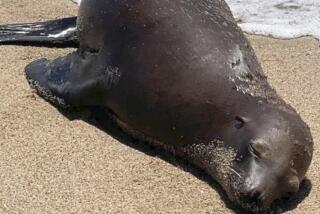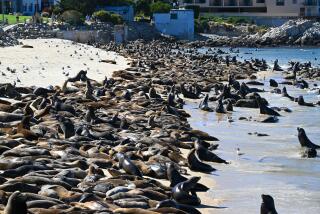Hoping to Capture Rare Footage of Shy Whales, Biologists Train Sea Lions to Carry Cameras : Film From the Deep
SANTA CRUZ â Jenifer Zeligs lowers one hand to her side and, on cue, Sake the sea lion touches it with his nose and then waddles obediently along beside her. âItâs the same as heeling your dog,â she explains.
This sea lion--kissing cousin to those that balance beach balls on their noses in zoos--is not at UC Santa Cruzâs Long Marine Laboratory to entertain. He is one of a quartet of California sea lions being trained to swim with gray whales and tape whale behavior with video cameras.
Sea lions are ideal, researchers in this experimental project believe. They âare certainly as trainable and as bright as a very intelligent dog,â says UC associate biology professor Daniel Costa.
Costaâs original goal was to study the sea lions and their âforaging ecology.â Then, James Harvey, an assistant professor of marine sciences at San Jose State University assigned to Moss Landing Marine Laboratory on Monterey Bay, came up with the idea of having sea lions videotape whales.
âWhales spend 95% of their time underwater,â says Harvey. âWe have a really biased view of what these animals do. The more we know, the better we will be able to protect them and the resources they require.â
Why use sea lions?
âHuman divers canât swim as fast or as deep as whales and, on top of that, would disturb the animals,â says Harvey. Sea lions, on the other hand, commonly swim next to whales âand the whales seem to continue doing their own thing.â
The education of Sake, Sushi, Hoover and Beaver--two males, two females--is being underwritten by, among others, the National Geographic Society and the Office of Naval Research.
As they swim and dive in their big tanks, they are doing sea lion aerobics. Harvey views them as âlittle athletesâ in training. By summerâs end, he hopes to see them swimming around the tanks with backpacks holding camera housings attached to their custom-made harnesses.
Next, Harvey will build a model of a medium-sized whale, about 38 feet long, and the sea lions will be taught to swim next to it in a lake or small pond and, eventually, in the open ocean. The model might be remote-controlled or it might be a phony whale built over a self-powered mini-sub.
Will it look like a real whale? Harvey hopes so. âI donât want this gray potato being dragged along.â
Two years from now, he projects, it will be all-systems-go, with the sea lions swimming parallel to real whales at a distance of 20 to 30 feet, their wide-angle lenses aimed toward the whalesâ heads.
Harvey, who believes the experiment is one-of-a-kind, hopes it will produce âthe first sort of full picture of what these animals do.â What are their social interactions? Reproductive behavior? Feeding patterns?
In other experiments, a camera has been attached to a subject animal but, as Harvey says, âFirst, you have to get it on and then you have to get it offâ--a tricky move--âand the picture is often not best taken from the back.â
Sea lions, who are faster swimmers and better divers, should have no trouble keeping pace with whales. âItâll be sort of boring for them, actually,â Harvey says.
The first subjects will be gray whales, which migrate by the thousands along the California coast. Then, perhaps, sea lions will photograph the threatened humpback whales.
The project isnât fail-proof. The sea lions âcould learn to swim with the model, but never make the jump to a real whale,â he says.
In the meantime, Zeligs and her team of 20 volunteers hope that what theyâre learning about their sea lions will tell them more about why other sea lion species, such as the Stellerâs, are in trouble--and how to save them.
Zeligs, 23, a psychobiologist working toward her Ph.D, is a natural as training coordinator for the sea lion project: She used to train seals, sea lions and bears at Washingtonâs National Zoo.
Two of her current pupils, Sake and Sushi, know a bit about survival. They were either separated or abandoned by their mothers and near death when rescued and rehabilitated at San Diegoâs Sea World. Hoover and Beaver are Navy vets.
California sea lions are not endangered. Indeed, Zeligs says, they âbreed like rabbitsâ in captivity. But monitoring them to learn how to expand sea lionsâ aerobic dive limits and their ability to hold their breath underwater (6 1/2 minutes, so far, on command) might help other species.
âItâs sort of like sports medicine for animals,â explains Costa, comparing it to human athletesâ quest to optimize performance.
Costa is interested in how sea lions decide how much energy to expend to find their prey, âthe decisions they make in terms of âgee, what am I going to have for dinner tonight?â â
And Costa has embraced Harveyâs vision of sea lion photographers. And then some. âIf we could train a sea lion to place a radio tag on a whale . . . â
Zeligsâ first challenge was âteaching them to trust us.â When sea lions do right, they are rewarded--with food, a game of Frisbee, a clump of seaweed to chew on and toss around.
So they wouldnât be afraid of music, she sang to them, but, she says, âThey didnât like my singing voice.â She brought in a radio and now, she says, âWe have sea lion rockers . . . and some of them like country and Western.â
They trust her enough to tolerate needle jabs to their rear quarters as she extracts blood samples.
And they now seem comfortable with their sturdy fabric harnesses. Says Zeligs, âIt was sort of like teaching a kid to wear clothes.â (Magnesium hardware on the harnesses would self-destruct in salt water in two days should a sea lion go AWOL in the ocean).
Asking a sea lion to sit still is, Zeligs says, akin to âasking a 2-year-old to sit still. They get very bored.â
Sake, under a plastic bubble in the tank, is tolerating having his metabolic rate measured, to see how much energy heâs burned in a dive. On command--âPillar!â--he jets out of the water and snags a fish.
The animals learn voice signals, such as âgood,â and learn to associate them with behaviors they know are right.
The key behavior is âtargeting,â wherein the animal is taught to touch its nose to an object--an anchor, a trainerâs hand.
When Zeligs wants an animal to lie down, she places her hand on the ground. If she wants it to get into the water, she places her hand there. âParalleling,â the equivalent of heeling, is taught this way.
The plan is to build open-air pens at nearby Moss Landing as a home base for the sea lions for their open ocean training.
Once they begin working out there, Zeligs expects the bonding with humans to pay off. âYou could stick recorders on (any) animal going out to sea, but youâd have no control over it--and you might not get your recorders back.
âWhen you enrich their lives to the extent we have, they choose to come back.â
(On one field trip, during which the sea lions were trucked to Monterey Bay to swim alongside a boat, Beaver took off. The next day he was back, Zeligs says, âand took a nap for about 12 hours.â)
The sea lions wonât have to worry about aiming or focusing their cameras. Their job will be to position themselves right. With luck, Zeligs says, the film wonât be â20 minutes of video of the middle of a whale.â
After all, there are all those whales to be filmed. Blues, grays, humpbacks . . .
But not killer whales.
Zeligs explains, âKiller whales eat sea lions.â
More to Read
Sign up for Essential California
The most important California stories and recommendations in your inbox every morning.
You may occasionally receive promotional content from the Los Angeles Times.










